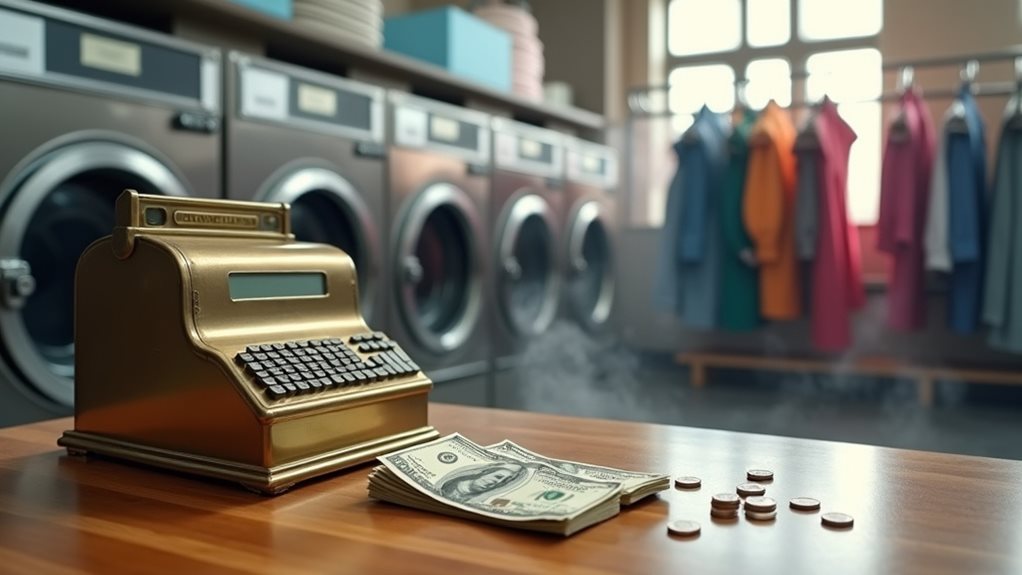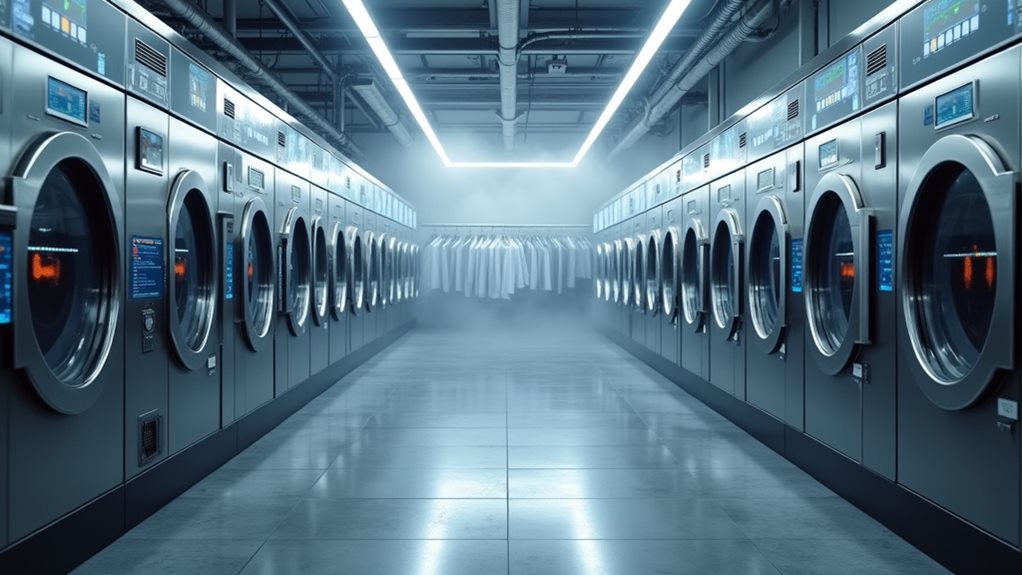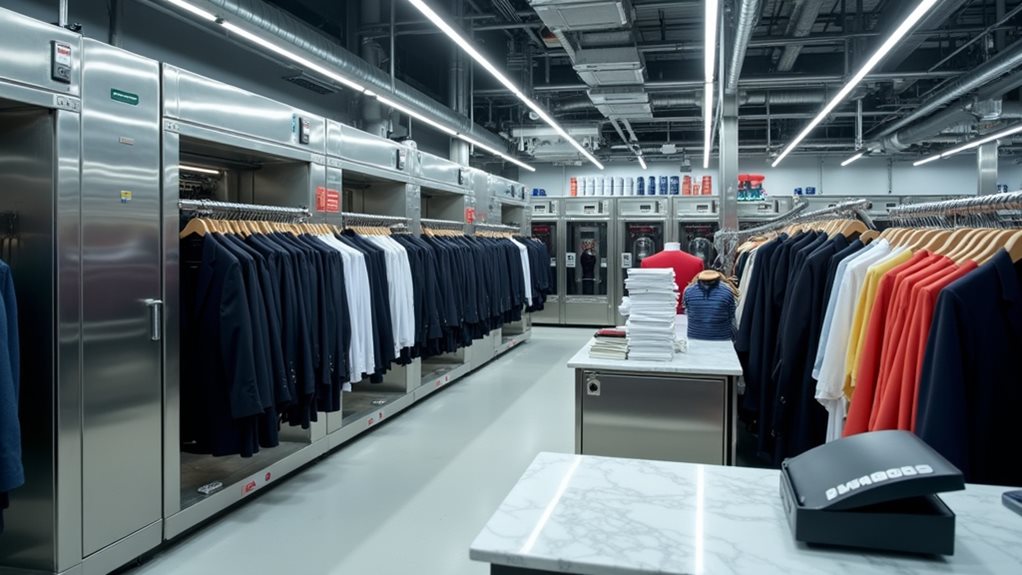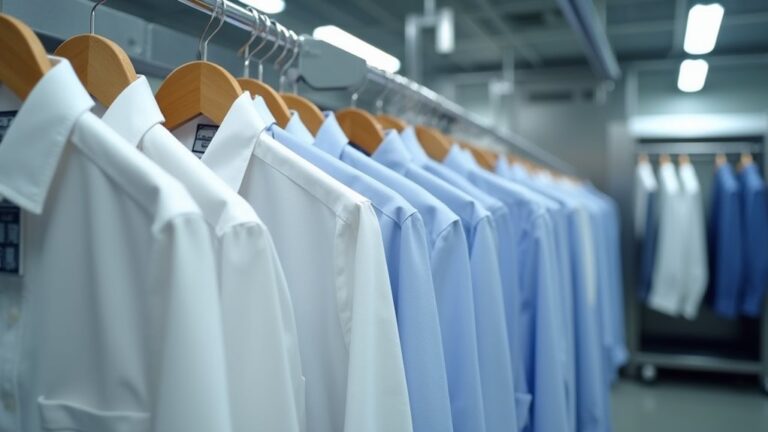Your dry cleaning business can earn anywhere from $24,000 annually in small towns to $360,000 in urban hotspots, though your actual take-home depends on how well you manage those pesky operating costs that average around $10,000 monthly. Most owners pocket between $40,000-$70,000 yearly with average performance, but I’ve seen exceptional operators pull in six-figure profits by mastering premium services and cost control. The devil’s truly in the details when it comes to maximizing your earning potential.
Revenue Streams and Pricing Structure for Dry Cleaning Operations
When you’re considering the financial terrain of dry cleaning, understanding your potential revenue streams becomes the foundation of your business success, much like how my neighbor discovered when she transformed her struggling laundry service into a thriving operation by diversifying her offerings.
Your pricing structure should reflect the complexity of each garment, with basic shirts earning $3-7 while intricate dresses command $10-20.
Smart pricing reflects garment complexity—simple shirts at $3-7, while elaborate dresses justify $10-20 based on cleaning demands.
Don’t underestimate additional services like stain removal or specialized pressing, which can boost each transaction by $2-5.
Smart dry cleaning operations also explore subscription packages, creating predictable monthly income while improving customer satisfaction.
Premium services like wedding gown cleaning or leather coat restoration can generate significantly higher margins, with specialty items potentially bringing in $30-100 or more per piece.
Customer Segmentation and Average Spending Patterns

Your customer base isn’t just a collection of people dropping off clothes—it’s a fascinating ecosystem of spending habits that’ll make or break your monthly revenue. This is something I learned firsthand when I helped my cousin analyze her dry cleaning receipts and discovered she was spending nearly $1,200 annually without realizing it.
Smart customer segmentation reveals two distinct groups: individuals averaging $20-50 per visit with 1-4 monthly trips, and businesses requiring bulk services that greatly enhance your revenue streams. Understanding these average spending patterns helps dry cleaning businesses balance operational costs effectively, since urban locations can generate around $10,000 monthly compared to small-town shops averaging $2,000.
This diversity creates multiple income channels, allowing you to adapt pricing strategies for maximum profitability. Research shows that most Americans spend between $200 to $500 annually on professional garment care, with business professionals and urban residents typically falling on the higher end of this range.
Annual Revenue Expectations by Location and Business Size

Three distinct revenue tiers emerge when you examine dry cleaning businesses across different locations and sizes, and honestly, the gaps between them surprised me more than finding out my neighbor was secretly a millionaire who just preferred doing his own laundry.
Small-town dry cleaning operations typically generate modest annual revenue around $24,000, which breaks down to roughly $2,000 in monthly income – enough to keep the lights on but not exactly yacht-buying money.
Small-town dry cleaners earn around $24,000 annually – enough to survive but not exactly retirement-fund material.
Urban dry cleaners benefit greatly from location advantages, pulling in approximately $120,000 annually with $10,000 monthly income streams.
Meanwhile, high-end metropolitan operations can achieve remarkable annual revenue of $360,000, demonstrating how location and business size directly correlate with earning potential in this industry.
These earnings can be significantly enhanced by offering specialty services like alterations, leather cleaning, and premium garment care that command higher prices and improve overall profitability.
Operating Expenses and Cost Management Strategies

Although those revenue numbers look promising on paper, managing the day-to-day expenses of running a dry cleaning business can feel like juggling flaming torches while riding a unicycle – challenging, but definitely manageable with the right techniques.
Your major operating costs will typically include chemical solvents, equipment maintenance, rent, staff wages, and utilities, which can easily reach $10,000 monthly in fixed expenses alone.
However, smart cost management strategies like negotiating with vendors and streamlining operations can slash your expenses by up to 20%, dramatically improving profitability for a dry cleaning business owner.
Green cleaning technologies might seem expensive initially, but they’ll boost your overall revenue by increasing profit margins 5-10%.
Regular expense reviews help identify efficiency improvements that directly impact your bottom line.
With effective cost management and operational efficiency, successful dry cleaning businesses can achieve profit margins between 15-25% annually.
Profit Margins and Breakeven Analysis

You’ll find that understanding your gross margins, which typically hover between 30% and 50% in dry cleaning, becomes the foundation for calculating whether you’re actually making money or just staying busy.
When I first started analyzing these numbers, I discovered that reaching your monthly breakeven point of around 2,000 pieces processed will cover those fixed expenses of roughly $10,000.
But here’s where it gets interesting – that’s just where you stop losing money, not where you start celebrating with champagne 🥂.
The real magic happens when you push beyond breakeven and start optimizing those profit margins, because every additional piece you process after hitting that 2,000-piece threshold flows much more directly to your bottom line.
Small independent dry cleaning shops typically achieve profit margins between 15-25%, which means your efficiency improvements and cost control measures directly impact how much you actually take home at the end of each month.
Gross Margin Calculations
When I first started analyzing dry cleaning businesses, I made the classic mistake of confusing gross margins with net profits, which led to some embarrassing conversations with potential investors who quickly realized I didn’t understand the fundamentals 😅.
Here’s what I learned: gross margins represent the percentage of revenue remaining after subtracting direct costs like chemicals, labor, and utilities. You’ll typically see ranges between 30% and 50%, depending on your operational efficiency and pricing strategy.
What’s fascinating is how eco-friendly practices can bump those margins slightly higher, while subscription-based models create predictable revenue streams that improve your calculations.
The key insight I wish someone had told me earlier is that understanding these profit margins isn’t just about numbers—it’s about identifying which levers you can pull to increase profitability.
After accounting for all expenses, most dry cleaning operations achieve net profit margins between 15-25%, which translates to significantly lower actual earnings than the gross margins might initially suggest.
Monthly Breakeven Requirements
Three critical numbers changed everything about how I approached dry cleaning profitability: 2,000 pieces processed monthly, $10,000 in fixed expenses, and that magical breakeven point where sleepless nights finally transform into sustainable income.
Your monthly breakeven requirements aren’t just numbers on spreadsheets—they’re the difference between surviving and thriving in this industry.
Location dramatically impacts your ability to meet these requirements, with small-town operators averaging $2,000 monthly while urban dry cleaning business owners reach $10,000.
Those profit margins between 10% and 25% determine how quickly you’ll climb above breakeven, while operating costs can either accelerate or sabotage your path.
I learned that managing every expense, from utilities to labor, creates breathing room that transforms breakeven from an impossible mountain into an achievable milestone 📈.
Understanding your startup costs, which typically range from $200,000 to $500,000, helps you calculate the monthly revenue needed to service initial investments and achieve true profitability beyond basic breakeven.
Owner Earnings Potential Across Different Performance Levels

Your dry cleaning business earnings will fluctuate dramatically based on how well you manage operations, market your services, and adapt to local competition—trust me, I’ve seen owners go from struggling to pay rent to driving luxury cars within merely a few years of smart pivots.
The difference between poor, average, and exceptional performance isn’t solely about working harder; it’s about understanding your numbers, investing in the right equipment, and building those loyal customer relationships that become your financial backbone.
Whether you’re barely scraping by at $30,000 annually or crushing it with six-figure profits, your performance level directly determines not only your paycheck, but your entire lifestyle and future business growth potential.
Small independent shops typically generate revenues between $200,000 to $500,000 annually, while larger operations can achieve profit margins ranging from 15% to 25% depending on their operational efficiency and market positioning.
Poor Performance Earnings
Although the dry cleaning industry offers legitimate pathways to financial success, I’ve witnessed firsthand how challenging it can be when your business falls into the poor performance category, where monthly earnings can plummet to as low as $600 – a figure that’ll barely cover your rent, let alone provide the comfortable living you’d envisioned when you first invested in those gleaming machines.
When operational costs spiral out of control and fierce competition eats away at your customer base, profitability becomes a distant dream rather than reality. You’ll find yourself struggling to cover fixed expenses like utilities, insurance, and equipment maintenance, creating a vicious cycle where poor earnings make it nearly impossible to invest in improvements that could boost performance and attract more customers back.
These struggling businesses often fall well below the industry’s typical profit margins of 15-25%, making it extremely difficult to justify the substantial initial investment and ongoing operational expenses.
Average Performance Returns
Moving beyond those disheartening scenarios, most dry cleaning businesses that achieve average performance levels can expect to generate annual gross revenues between $150,000 and $300,000, which translates to owner earnings that’ll actually pay your bills and maybe even fund that vacation you’ve been postponing for three years 😊.
Your net profit margins will typically hover around 5% to 8% with traditional dry cleaning services, meaning you’re looking at roughly $7,500 to $24,000 annually.
The average price you charge per garment, combined with understanding your customer demographics and maneuvering through the competitive environment effectively, determines where you’ll land within this range.
It’s not glamorous money, but it’s honest work that can support a modest lifestyle.
These earnings align with industry standards where most dry cleaning owners fall within the $40,000 to $70,000 range depending on operational efficiency, location advantages, and business size.
Exceptional Performance Profits
Several exceptional dry cleaning operators break through those modest earnings ceilings by implementing strategic innovations, premium service offerings, and operational excellence that can push monthly profits to $15,000 or even higher for the most successful owners.
These top performers understand that your dry cleaning business thrives when you focus relentlessly on operational efficiency while adapting to market demand shifts throughout the year.
I’ve witnessed owners who’ve mastered the art of strategic pricing, eco-friendly services, and subscription models achieve profit margins exceeding 10% – nearly double the industry standard.
They’re not merely pressing clothes; they’re orchestrating customer experiences that justify premium pricing. 😊
The secret sauce? Treating each garment like it belongs to your best friend’s wedding, while maintaining systems that would make a Swiss watchmaker proud.
Market Growth Opportunities and Industry Trends

When you’re considering the financial potential of a dry cleaning business, understanding the industry’s growth trajectory becomes absolutely vital for your success.
The dry cleaning industry is experiencing solid momentum with a 3.4% compound annual growth rate projected through 2028, creating genuine market growth opportunities worth your attention. Consumer demand continues strengthening as disposable incomes rise and unemployment stays low, meaning more people can afford professional garment care.
Here are three key trends reshaping profitability:
- Eco-friendly practices attract environmentally conscious customers willing to pay premium prices.
- On-demand delivery services expand your customer base beyond traditional walk-ins.
- Integration with laundry services creates additional revenue streams from the $60.88 billion market.
These shifts aren’t just industry buzzwords—they’re real opportunities to boost your bottom line considerably.




